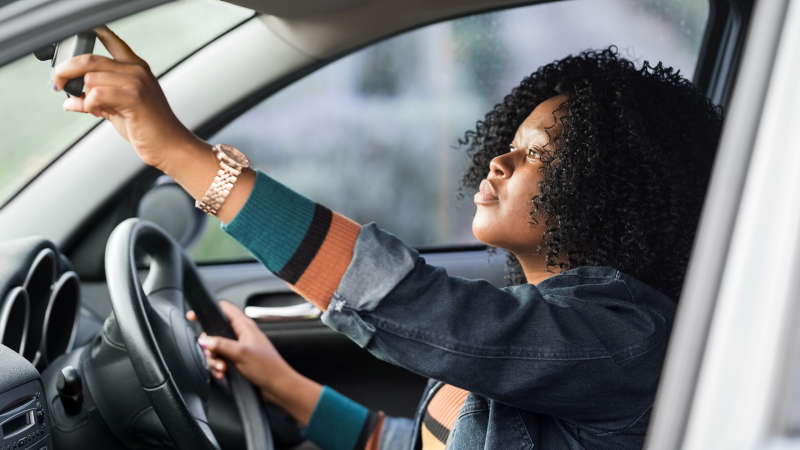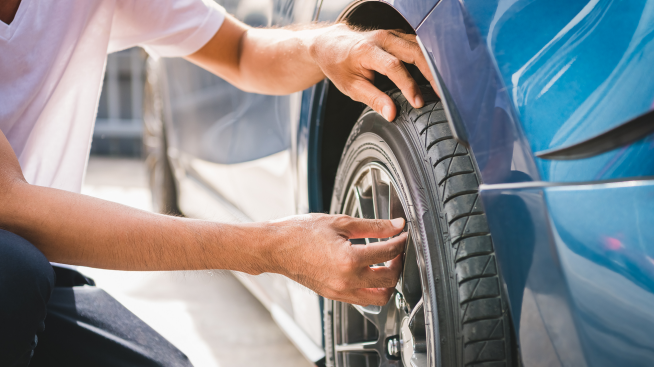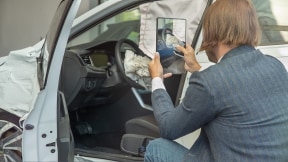Blind spots: A driver's guide

A car blind spot refers to an area of your car where nearby vehicles fall outside the scope of both your rear and side view mirrors. It then becomes difficult to see cars in your blind spot when your eyes are on the road in front of you, which could potentially lead to a collision. Thankfully, a little bit of knowledge and subsequent precaution can help minimize that risk.
Where are the blind spots on a car?
Vehicles have at least two blind spots, one on each side of the car. As a car behind you passes along the side, it goes from being in your rearview mirror to your side view mirror. Then, it gets to an area that’s beyond the angle of your side view mirror and not quite far enough to be visible in the corner of your eye when you’re looking at the road in front of you. This area on either side of your car is what most people refer to as the blind spots on a car, though there may be other blind spots as well depending on the type of vehicle and its design. Essentially, the bigger the car, the bigger the blind spot.
Blind spots apply not only to what you see while driving, but what other drivers see as well. A good rule of thumb to remember is that if you can’t see their mirrors, they can’t see you.
What makes car blind spots so dangerous?
Being able to see other drivers around you is critically important to keeping you and other drivers safe on the road. Imagine that you’re passing someone. You've moved out of their rear and side view and are in the other driver’s blind spot. If that other driver isn’t aware of your presence and decides to switch lanes just then, there is a risk of crashing into you.
Tips to help avoid or minimize your car’s blind spot
There are things you can do as a driver to help minimize and manage the potential risk that car blind spots can pose:
Adjusting your mirrors
Adjusting your mirrors properly is one of the most important ways to mitigate your blind spots. When adjusting your mirrors, it helps to do so from your driver’s seat with your head in its usual driving position. Properly angled side-view mirrors should only reveal a small sliver of your car’s body on either side. A properly angled rearview mirror should offer a clear view of the entire back windshield. It's good practice to inspect your mirrors every time you drive to ensure they're in their optimized positions.
Being familiar with your blind spot
It helps to be familiar with your car's blind spots. A good way to safely get a feel for where they’re located is to try to locate your blind spots while you’re sitting parked somewhere. It may even be beneficial to get a feel for approximately how long it takes a car to exit your blind spot. You could potentially ask a friend to drive past you as you’re parked. This way, if you notice a car has entered your blind spot, you’ll have a better sense of how much time to add before your next move to ensure the other car is clear.
Being mindful
Mindfulness is a desirable skill as a driver. Doing things like taking an extra moment to ensure no one’s coming before making a move can go a long way toward helping ensure your safety. Being mindful of another driver’s blind spot is also helpful so you can avoid lingering there too long. It’s also good practice to be mindful of your signaling by doing it far enough in advance for other drivers to have adequate time to respond to it.
Using a quick shoulder check
When trying to switch lanes, you could utilize a quick over-the-shoulder look toward your car’s blind spot to ensure it’s clear before proceeding.
When utilizing a shoulder check, it helps to exercise caution and be aware of your surroundings before attempting it. It's also best to turn your eyes back to the road ahead of you as quickly as possible.
Blind spot monitoring
Automakers are constantly deploying new technology to keep consumers safe, and they didn’t forget to address the blind spot. A blind spot monitor uses cameras, radar and more to detect objects that are in or approaching your blind spot, and then alert you to their presence. Blind spot monitoring may also be known as blind spot warning, blind spot detection, blind spot information system or some other such variant, depending on the carmaker.
Some versions of these systems can even provide feedback if you attempt to turn into that lane while someone is in your blind spot, like vibrating the steering wheel. There are also assisted versions that can physically adjust your steering or hit the brakes if you’re in danger of hitting something in your blind spot. Consult with your owner’s manual to see if your car has any of these features available. If not, they may be something to consider the next time you buy a car.
In summary
Car blind spots are worth taking seriously, but they’re no reason to be scared — it can be managed with a little know-how. Every car has some blind spots, and good drivers take the time to familiarize themselves with them. This understanding can help you develop a sense of how long it takes for someone to clear your blind spot. It also helps to get a feel for other drivers’ blind spots too. You can also use technology like blind spot monitoring systems to help you, which could be a feature to look out for the next time you’re car shopping.



